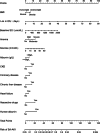A novel risk-predicted nomogram for sepsis associated-acute kidney injury among critically ill patients
- PMID: 33971853
- PMCID: PMC8111773
- DOI: 10.1186/s12882-021-02379-x
A novel risk-predicted nomogram for sepsis associated-acute kidney injury among critically ill patients
Abstract
Background: Acute kidney injury (AKI) is a prevalent and severe complication of sepsis contributing to high morbidity and mortality among critically ill patients. In this retrospective study, we develop a novel risk-predicted nomogram of sepsis associated-AKI (SA-AKI).
Methods: A total of 2,871 patients from the Medical Information Mart for Intensive Care III (MIMIC-III) critical care database were randomly assigned to primary (2,012 patients) and validation (859 patients) cohorts. A risk-predicted nomogram for SA-AKI was developed through multivariate logistic regression analysis in the primary cohort while the nomogram was evaluated in the validation cohort. Nomogram discrimination and calibration were assessed using C-index and calibration curves in the primary and external validation cohorts. The clinical utility of the final nomogram was evaluated using decision curve analysis.
Results: Risk predictors included in the prediction nomogram included length of stay in intensive care unit (LOS in ICU), baseline serum creatinine (SCr), glucose, anemia, and vasoactive drugs. Nomogram revealed moderate discrimination and calibration in estimating the risk of SA-AKI, with an unadjusted C-index of 0.752, 95 %Cl (0.730-0.774), and a bootstrap-corrected C index of 0.749. Application of the nomogram in the validation cohort provided moderate discrimination (C-index, 0.757 [95 % CI, 0.724-0.790]) and good calibration. Besides, the decision curve analysis (DCA) confirmed the clinical usefulness of the nomogram.
Conclusions: This study developed and validated an AKI risk prediction nomogram applied to critically ill patients with sepsis, which may help identify reasonable risk judgments and treatment strategies to a certain extent. Nevertheless, further verification using external data is essential to enhance its applicability in clinical practice.
Keywords: Acute kidney injury; Intensive care unit; Nomogram; Prediction; Sepsis.
Conflict of interest statement
None of the authors have any conflicts of interests to declare.
Figures





Similar articles
-
[Construction and validation of a risk nomogram for sepsis-associated acute kidney injury in intensive care unit].Zhonghua Wei Zhong Bing Ji Jiu Yi Xue. 2024 Aug;36(8):801-807. doi: 10.3760/cma.j.cn121430-20240221-00150. Zhonghua Wei Zhong Bing Ji Jiu Yi Xue. 2024. PMID: 39238403 Chinese.
-
A nomogram incorporating functional and tubular damage biomarkers to predict the risk of acute kidney injury for septic patients.BMC Nephrol. 2021 May 13;22(1):176. doi: 10.1186/s12882-021-02388-w. BMC Nephrol. 2021. PMID: 33985459 Free PMC article.
-
Nomogram to predict the risk of septic acute kidney injury in the first 24 h of admission: an analysis of intensive care unit data.Ren Fail. 2020 Nov;42(1):428-436. doi: 10.1080/0886022X.2020.1761832. Ren Fail. 2020. PMID: 32401139 Free PMC article.
-
Preoperative risk prediction models for acute kidney injury after noncardiac surgery: an independent external validation cohort study.Br J Anaesth. 2024 Sep;133(3):508-518. doi: 10.1016/j.bja.2024.02.018. Epub 2024 Mar 24. Br J Anaesth. 2024. PMID: 38527923
-
Biomarker Enrichment in Sepsis-Associated Acute Kidney Injury: Finding High-Risk Patients in the Intensive Care Unit.Am J Nephrol. 2024;55(1):72-85. doi: 10.1159/000534608. Epub 2023 Oct 16. Am J Nephrol. 2024. PMID: 37844555 Free PMC article. Review.
Cited by
-
Predictive models of sepsis-associated acute kidney injury based on machine learning: a scoping review.Ren Fail. 2024 Dec;46(2):2380748. doi: 10.1080/0886022X.2024.2380748. Epub 2024 Jul 31. Ren Fail. 2024. PMID: 39082758 Free PMC article.
-
AKI prediction model in acute aortic dissection surgery: nomogram development and validation.Front Med (Lausanne). 2025 May 15;12:1562956. doi: 10.3389/fmed.2025.1562956. eCollection 2025. Front Med (Lausanne). 2025. PMID: 40443509 Free PMC article.
-
A study on the factors influencing mortality risk in sepsis-induced acute kidney injury based on analysis of the MIMIC database.Clin Exp Med. 2025 Jun 7;25(1):192. doi: 10.1007/s10238-025-01681-4. Clin Exp Med. 2025. PMID: 40481893 Free PMC article.
-
Development and validation of a novel risk-predicted model for early sepsis-associated acute kidney injury in critically ill patients: a retrospective cohort study.BMJ Open. 2025 Jan 28;15(1):e088404. doi: 10.1136/bmjopen-2024-088404. BMJ Open. 2025. PMID: 39880446 Free PMC article.
-
Nomogram for predicting fulminant necrotizing enterocolitis.Pediatr Surg Int. 2023 Mar 20;39(1):154. doi: 10.1007/s00383-023-05435-9. Pediatr Surg Int. 2023. PMID: 36939896 Free PMC article.
References
-
- Rhodes A, Evans LE, Alhazzani W, Levy MM, Antonelli M, Ferrer R, Kumar A, Sevransky JE, Sprung CL, Nunnally ME, et al. Surviving Sepsis Campaign: International Guidelines for Management of Sepsis and Septic Shock: 2016. Intensive care medicine. 2017;43(3):304–377. - PubMed
-
- Skube SJ, Katz SA, Chipman JG, Tignanelli CJ. Acute Kidney Injury and Sepsis. Surgical infections. 2018;19(2):216–224. - PubMed
Publication types
MeSH terms
Substances
LinkOut - more resources
Full Text Sources
Other Literature Sources
Medical

